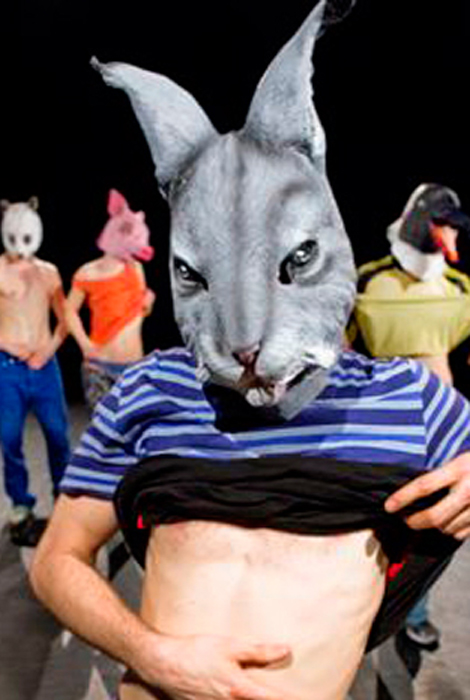Remarkable dancing, this bold and bizarre work offers undeniable truth
15/06/2011
“Animal Lost,” by choreographers Yossi Berg and Oded Graf is a strange bird of a dance – and “did I mention zebras, tigers and my lollipops?” The dance begins with this line, within a nonsensical poem recited by a tall, leggy woman who soon dons a horse mask and tells corny horse jokes into a microphone. Complete with a menagerie of animal masks, water guns, pop songs, and remarkable dancing, this bold and bizarre work offers both nonsense and sensuality, ridiculous situations and undeniable truth.
Berg and Graf, collaborators since 2005, have developed an international reputation for creating dances that are provocative and powerful. “Animal Lost,” created in 2010, is no exception. It takes risks – and most of them work – as it tackles the loaded subjects of identity and sexuality with humor and a focused intensity.
After a misty, benign striptease during which the masked dancers – a horse, polar bear, penguin, panda, pig, and bunny – nonchalantly unzip their jackets, undo their belts, and wriggle halfway out of their clothes (never stopping the peppy bounce of their hips), the fantasy breaks, and they shrink back into their clothes. Eventually, they remove their masks and throw themselves into volatile duets and trios.
The partnering is brilliantly odd. As the dancers wrap around and fit into and through each other’s bodies, the parts don’t fit neatly, though they always find a way to join. They poke and skim and slice and burrow, ricocheting away and then melting into their partner. These couplings are awkward, sometimes almost violent, other times bordering on tender. Their urgency seems infused by a sort of animal desire – raw and blind and confused but its hard to say these are sexy duets. Its not pretty, but there is room for a strange beauty in the reality that is revealed about the way they – we – come together.
Early in the dance, the dancers announce their “identities”: “I am a Danish dentist, and I make lots of mistakes”; “I am an American comedian. I spit when I talk and I sweat.” The declarations take on a confessional tone, and they begin to blur, as the statements reappear in another “identity.” In fact, the words become meaningless, as they come faster and faster, each dancer claiming multiple personas, though it’s clear that none of them are real. The ways we are described, or how we describe ourselves, cannot tell the whole story.
The movement vocabulary, although clearly shaped by each of the six dancers, has a consistent sense of fluidity and idiosyncratic gesture, but remains nearly indescribable. At points, it seems like dancing by free association, switching with a quicksilver flash from one movement idea or style to another, and yet, still seeming to make sense.
The whole dance is like this, combining incongruous scenes into a peculiar logic. The most powerful moments for me were those that exposed the razored edge of reality beneath the fantasy, the tightly bound knots of pleasure and pain. The program notes explain that the performers are trying to “wake the animal inside of them,” but I sensed a more complicated set of urges. They test the uneasy balance between naming oneself and throwing out all identifiers, choosing to be someone else and accepting oneself. These dancers seem to struggle to probe, stifle, and accept their “animal” natures – something primal, and paradoxically, very human.
Posted with permission of the author and World Dance Reviews (www.worlddancereviews.com). Copyright World Dance Reviews.
– Anne Morris, World Dance Reviews

Photo Christoffer Askman